Construction of the first Soviet Arctic icebreakers
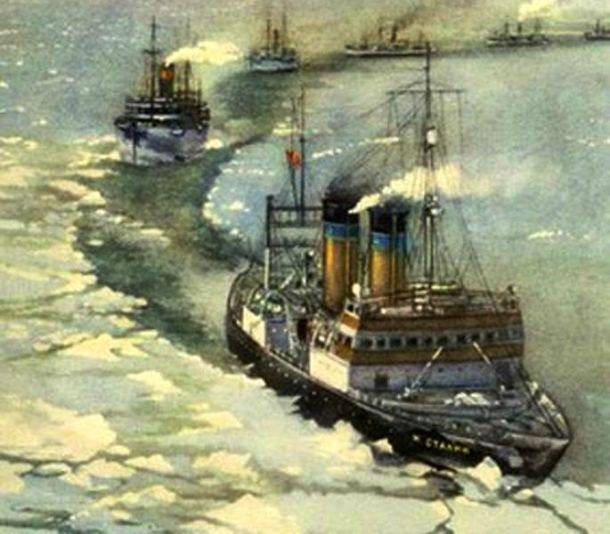
In the early thirties, it became clear that the scale of research work in the Arctic and the number of transport vessels, especially to such distant areas of the Northern Sea Route as the mouth of the Lena and Kolyma, require powerful icebreakers. In fact, there were only two such icebreakers in our country at that time - Krasin and Ermak, only they had sufficiently powerful three-screw power plants. After the Lena expedition was completed, the Krasin icebreaker team supported the propaganda of the construction of a powerful Arctic icebreaker that was unfolding at the time. fleet. The people of Krasnoyarsk not only called for the start of the construction of such icebreakers, but also offered to organize a wide campaign to promote the construction, start collecting proposals on the characteristics of the icebreakers, and accept patronage of the construction. Further developments also took place in the spirit of the time when the country tried to combine state planning and initiative “from below”. On December 9, 1933, the Presidium of the Central Committee of the Water Transport Workers Union created the “Commission for the Mass Assistance in the Construction of Arctic Icebreakers”, and the Water Transport newspaper began to print letters with the wishes for what the icebreaker should be for the Arctic, including proposals from such famous Arctic captains, as M. Ya. Sorokin and N. M. Nikolaev.
In December 1933, the Krasin came to Leningrad, where it was supposed to be repaired to prepare for the next year’s navigation. But the events in the Arctic in February 1934-th dramatically changed these plans. Almost at the entrance to the Bering Strait, the Chelyuskin icebreaking ship sank, and extensive rescue operations began to remove the crew and the expedition crew from the drifting ice. February 14 by a special decision of a government commission chaired by V.V. Kuybyshev “Krasin” was ordered to urgently go to the Far East, to assist Chelyuskinites. In this connection, the repair of the icebreaker and its preparation for leaving Leningrad were entrusted to the Baltic and Kronstadt plants. The workers of these enterprises managed to do an enormous amount of work within a month, and on March 23 the icebreaker left Leningrad, heading for the Atlantic and the Panama Canal to the Far East.
On the instructions of Glavsevmorput, Sudoproek began to develop two projects for icebreakers for the Arctic: with a steam installation with an indicator power of 10 ths. Hp, or 7353 kW (according to the Krasin prototype), and a diesel-electric one - with power 12 ths. Hp (8824 kW).
At the preliminary design stage, projects were discussed in June 1934 at a special meeting in the Council of People's Commissars. Although academician A.N. Krylov and pointed to the premature construction of diesel-electric icebreakers, the meeting recommended to build icebreakers on both projects. The government assigned this task to the People's Commissariat of Industry. However, due to the large shipbuilding program and the difficulties of supplying the component equipment, the construction of icebreakers with diesel-electric installations was subsequently abandoned. It was planned to build a series of four steam-powered icebreakers: two each at the Baltic and Black Sea plants.
The government’s decision to build these vessels was not left without influence, and the scientists who worked in the field of icebreaking. The journals “Shipbuilding” and “Water Transport” began to publish articles by A.N. Krylova, Yu.A. Shimanskogo, L.M. Nogida, I.V. Vinogradova et al. Technical project (chief designer KK Bokhanevich) was carried out by the team of Sudoproekt, working drawings were created by the design bureau of the Baltic Shipyard; Experienced designers such as VG worked on it. Chilikin, V. Ashik, A.S. Barsukov, V.I. Neganov, L.V. Tageev. At the same time, the selection of the maximum power and its distribution among the screws, the strength of the propeller shafts and screws, the use of alternating current, the development of typical hull structures, recommendations on the coefficients of completeness, shape and hull lines were investigated. Crepe and trim systems were developed. A list of auxiliary mechanisms that could be supplied by the domestic industry was compiled, and steam and turbine dynamo designs for power plants were tested. Working drawings of steam machines with a capacity of 3300 l. with., to accelerate the construction, purchased from the British company "Armstrong", at one time built "Ermak". The project has been assigned an 51 number. The lead ship laid down at the Baltic Shipyard received the sonorous name “I. Stalin ", later in 1958, he was renamed" Siberia ". The next ships in the series were “V. Molotov "(" Admiral Makarov "), also built in Leningrad, then" L. Kaganovich "(" Admiral Lazarev ") and" A. Mikoyan "Nikolaev built.
The draft of the icebreakers provided for the following provisions: an increase in autonomy due to a decrease in the specific fuel consumption as a result of steam overheating, heating of boiler feed water; the preservation of the icebreaking properties of the vessel at full draft (with maximum fuel supplies of 3000 tons) due to a change in the bow tip (“Krasin” partially lost ice-breaking abilities at full reserves); welded assemblies were introduced into some hull structures; instead of steam-powered cargo cranes, electric power was installed, for which the power of the ship’s power station was increased, a turbine dynamo was envisaged, which was an innovation in the icebreaking industry; watertight bulkheads between engine rooms and boiler rooms were equipped with power-operated klinket doors from both central and central posts ( "Krasine" communication between the compartments was carried out through the residential deck); Significant improvement in crew living conditions: accommodation in four, double and single cabins; the creation of a laboratory for scientists on the upper deck, etc. The complex shape of the hull, thick sheets of plating, large individual parts, a large number of residential and office premises - all this created considerable difficulties in the construction of icebreakers, forcing in a very short time to significantly improve the organization and shipbuilding technology.
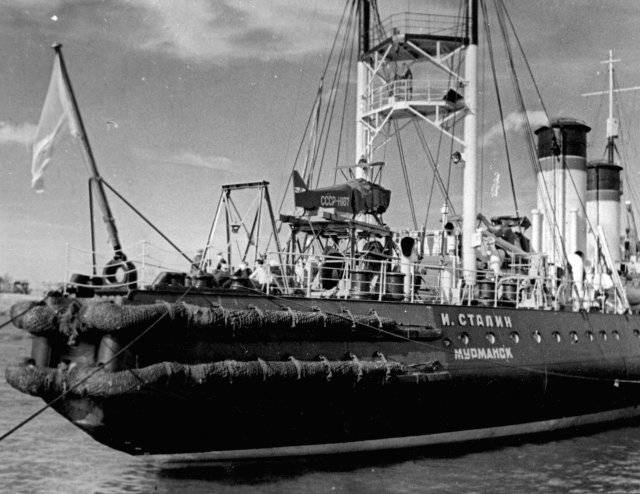
We present the basic design characteristics of the 51 Pr icebreakers: 106,6 length, 23,12 width, 11,64 depth, 7,9-9,04 draft, m 11 displacement, kt, clean speed 15,5 people, 142 crew, power plant consisted of nine fire tubes circulating type boilers (steam pressure 15,5 kg / sq. cm) operating on coal and three steam engines with a total capacity of 10 thousand liters. s., the speed of the propeller shaft 125 rpm (three screws with a diameter of 4100 mm had a pitch 4050 mm); The power plant with a constant voltage 220В consisted of two turbo-generators with a capacity of 100 kW, a parodynamo with a capacity of 25 kW, and emergency diesel generators 12 and 5 kW. The cargo equipment consisted of two winches with a total carrying capacity of 4 t, two booms with a total carrying capacity of 15 t; two truck mounted electric cranes for 15 tons and four cranes for 3 tons; very powerful fire-fighting and drainage facilities were envisaged.
The power plant of the icebreaker was significantly different from the installations of transport vessels, which the design bureau of the Baltic Shipyard had worked on before. Three large-sized machines, located in two engine rooms, a significant number of auxiliary mechanisms, four boiler rooms, a complex system of pipelines — all this created difficulties in placement and layout. It should be noted that our designers did not have sufficient experience in designing power plants for icebreakers; Something had to be done on the basis of the actual data on the prototype (for example, the diameter, air tubes of ballast, trim and roll tanks were chosen). The issue of chimneys was not immediately resolved: the Balts conceived to make them straight, like Yermak, but the designers of the Black Sea Plant, having received drawings from Leningrad, made the pipes tilted like Krasin's. Later, the sailors unmistakably piped the icebreakers built by the Baltic and Black Sea plants.
By the summer of 1935, the building was developed on a broad front in both enterprises: a housing layout was distributed, keel sheets, bottoms, templates were prepared, tooling and accessories were made, sheet and long-term metal began to be supplied to warehouses. On October 23 of the same year, the official laying of both ships took place at the Baltic Shipyard (the main builder, GA Kuish), and a month later - the first icebreaker on the Black Sea. In Leningrad, the ceremonies of the bookmarks were attended by the head of the Central Sea Route O. Yu. Schmidt, N.I. Podvoisky, Professor R. L. Samoilovich. Silver icebreakers were laid in the keels of icebreakers with the emblem of the USSR engraved on them and the slogan "Workers of all countries, unite!", The date of laying and texts about the contribution that these icebreakers will make to the development of the Arctic.
For the Black Sea coast, the construction of icebreakers proved to be particularly difficult, as they had previously built tanker-ships, having mastered the installation, fine-tuning and testing of diesel engines. The skills of manufacturing, assembling and installing steam engines, steam auxiliary mechanisms and fire tube boilers have been largely lost. Difficulties experienced by corpsmen, who had to deal with thick sheets, were customized and riveted double casing with a total thickness of up to 42 mm. There were strict requirements for testing the watertight compartments. Interruptions in the supply of sheet material affected the timing of construction. With a planned 25% technical readiness on 1 January 1936, the actual was only 10%. From the very beginning, the Balts were doing better, since they had experience in repairing icebreakers who helped them in icebreaking. But they, too, had to face great difficulties in carrying out the slipway works; The reason was the complex contours and configuration of the pins, reinforced set in the bow. The case was assembled in the old-fashioned way (not by the sectional method), so a lot of work was spent on making templates and frames, “hot” fitting sheets and sets. The coordination of the hull sheets with the stern stem and the stem, as well as the work on the shaft fillet turned out to be especially laborious. The greatest difficulty was the installation of a double skin, which, due to the absence of a single sheet of the desired thickness, was carried out across the entire ice belt of two sheets. The fitting of sheets of complex configuration X-NUMX-20 mm thickness “one to one” without a gap, can truly be called a jewelry work. To fill in the possible voids between the sheets of double skin, douching with red lead was used.
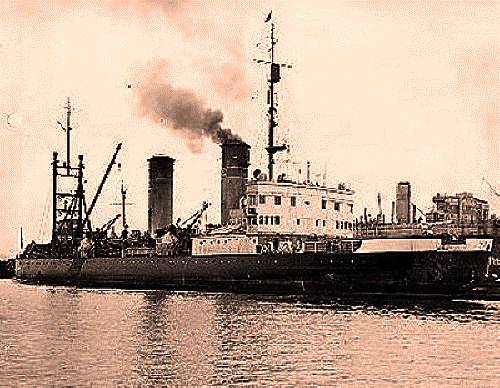
The process of manufacturing and installation of the main steam engines was also accompanied by considerable difficulties. On the bench tests in Leningrad, the main machine developed the 4000 power indicator l. with. On the basis of the experience gained by the Baltic, the Black Sea Plant managed to assemble the machines after assembly immediately on board the ship.
Nikolayevtsa 29 on April 1937 of the year launched the first icebreaker into the water, Leningraders in August of the same year. During the descent, braking by chain dredges was applied, as well as paraffin paddle, proposed by the well-known specialist in launching ships D.N. Zagaikevich
On the first Black Sea icebreaker, later known as "Lazar Kaganovich", the final stage of completion began. In advance and carefully selected crew (captain - famous polar sailor N.M. Nikolayev, senior assistant - A.I. Vetrov) took an active part in the preparation of mechanisms for surrender, in mooring and resource tests. Seafarers needed to study the technique better, since immediately after receiving the vessel they had to make the transition from the Black Sea to the Far East, through the Suez Canal and the Indian Ocean. The operating experience of the Krasin icebreaker made it possible to introduce a number of innovations to control and facilitate the control of the machine-boiler installation. A central mechanic's station with instrumentation from all machines, as well as a central console for controlling the temperature of exhaust gases of boilers, was equipped at the control panel of on-board machines, which made it possible to equalize their load.
In August — September, 1938, at Chersonesus and Cape Fiolent, sea trials of an icebreaker built in Nikolaev were carried out. With a draft of 7,9 m and full revolutions of the machines, the continuous power was 9506 l. with. (6990 kW), and speed - 15,58 knots. Specific fuel consumption ranged from 0,97 to 1,85 kg / l. with. (1,32-2,5 kg / kW). In the calculation of the boiler plant, the designers re-evaluated the quality of the coal used in the fleet in those years. The steam in the boilers was “difficult to keep”, the voltage of the grate, to obtain the required amount of steam, turned out to be excessive.
After a thorough revision of the mechanisms, at the end of December 1938, the control exit of the first icebreaker of the Black Sea shipbuilders took place. 11 January 1939 of the year. Government Commission chaired by the famous polar explorer E.T. Krenkel began accepting the vessel. 3 February 1939 of the year was signed by the acceptance act, and preparations began for the release of "Lazar Kaganovich" to the Far East. The transition to tens of thousands of miles, immediately after the surrender, proved to be an ordeal, however, both the ship and the crew successfully withstood it. In March, “Lazar Kaganovich” began intensive work in the Far Eastern waters: the steamer “Turkmen” pulled out of ice jams in the Strait of La Perouse, first opened such early navigation in the Sea of Okhotsk in April, and entered the Arctic sector as the flagship icebreaker of the Northern Sea Route in June . The arrival to the Far East of a powerful domestic Arctic icebreaker was a decisive factor in the implementation of significantly increased plans for the importation of Arctic cargo throughout the eastern sector and ensuring the passage of a large number of transport ships in the ice.
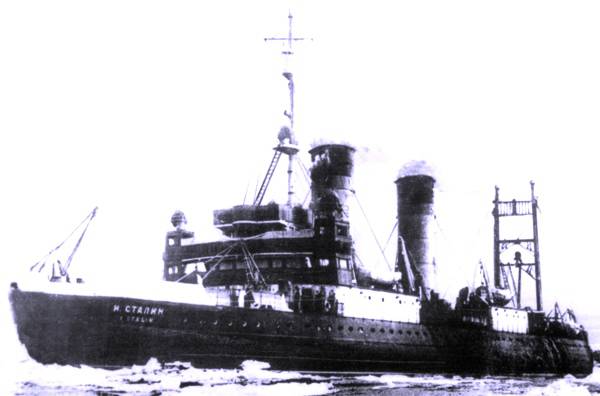
In September, 1939, in the port of Pevek, a meeting of the icebreaker “I. Stalin "with the icebreaker" Lazar Kaganovich ", built by the Black Sea plant. The results of the trouble-free crossing by the southern route to Vladivostok and further work testified to the high reliability of the equipment and the hull of the icebreaker built in Nikolaev. When summing up the Arctic navigation 1939 year, his crew was praised by the leadership of the Northern Sea Route.
In 1941, the rest of the icebreakers went into operation: the Nikolayev residents surrendered the icebreaker Anastas Mikoyan, and the Leningrad residents — “V. Molotov. The latter, after a series of shipments to Kronstadt, remained in blockaded Leningrad, and the “Anastas Mikoyan” commanded by comrade. Sergeeva, in December 1941, left the port of Poti and, in wartime conditions, made a heroic flight through the Bosphorus, the Suez Canal, the Red Sea, the Indian Ocean, around the Cape of Good Hope and the Horn, across the Pacific Ocean; arriving in Provideniya Bay in mid-August, he began ice pilotage in the eastern sector of the Arctic. During the Great Patriotic War, the great importance of the Northern Sea Route as a vital transportation route of our country was confirmed. It is hard to imagine the development of events in the North if by the beginning of the war our Arctic icebreaking fleet had not been replenished with four powerful icebreakers.
Construction and commissioning of such complex in construction and manufacturing technology, saturated with technical facilities objects, such as Arctic icebreakers, were a major success of the domestic shipbuilding industry of the prewar years. And after 20 years after the start of the construction of steam icebreakers, using the experience accumulated during their construction and operation, the nuclear-powered icebreaker Lenin, the first-born of the global nuclear icebreaking industry, was launched.
Sources:
Andrienko V. Port and offshore icebreakers of Russia // Shipbuilding. 2002. No. 2. C. 72-77.
Kashtelyan V., Ryvlin A., Faddeev O., Yagodkin V. Ledokoly. L. Shipbuilding, 1972. C. 10-13.
Evseev L. The first Soviet icebreakers // Technique - youth. 1976. No.8. C. 48-49.
Stefanovich A. The first arctic icebreakers of Soviet construction // Sudostroeni. 1989. No.1. C.55-57.
Boechin I. The Magnificent Four // Technique - Youth. 1995. No.5. C. 26-27.
Shirokorad A. Battle of the Russian Arctic of the XVI-XXI centuries. M .: Veche, 2008. C.237-241.
Belkin S. Crushing ice. M .: Knowledge, 1983. C. 107-119.
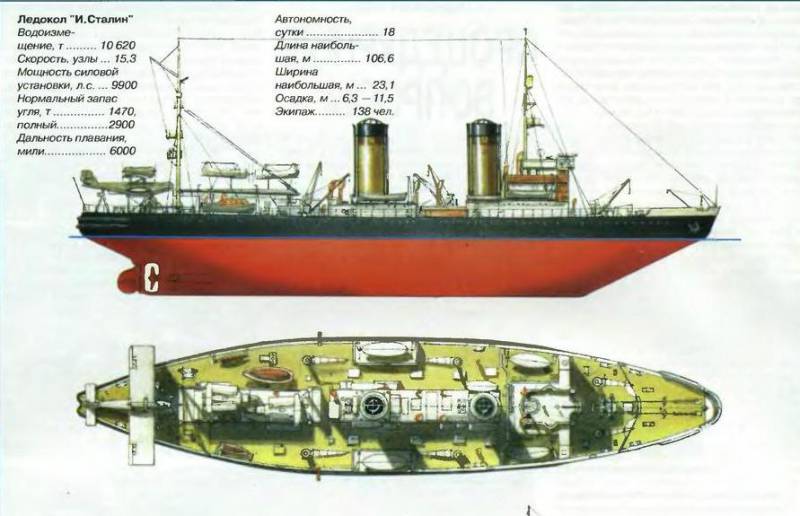
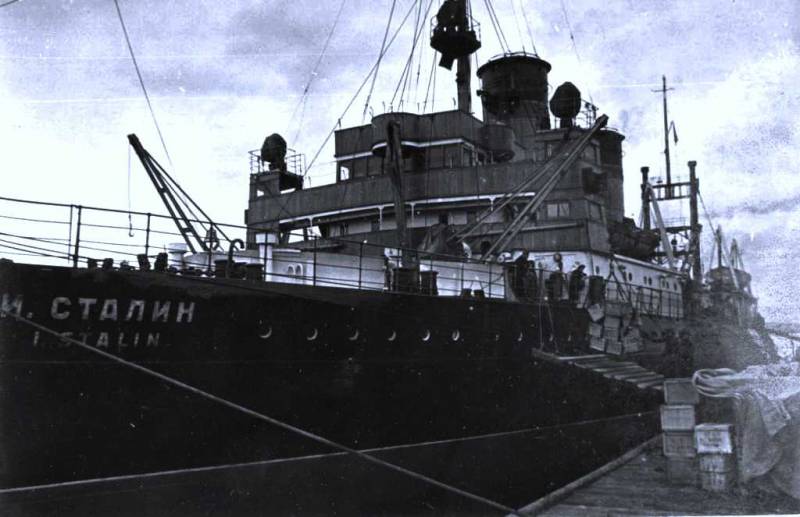
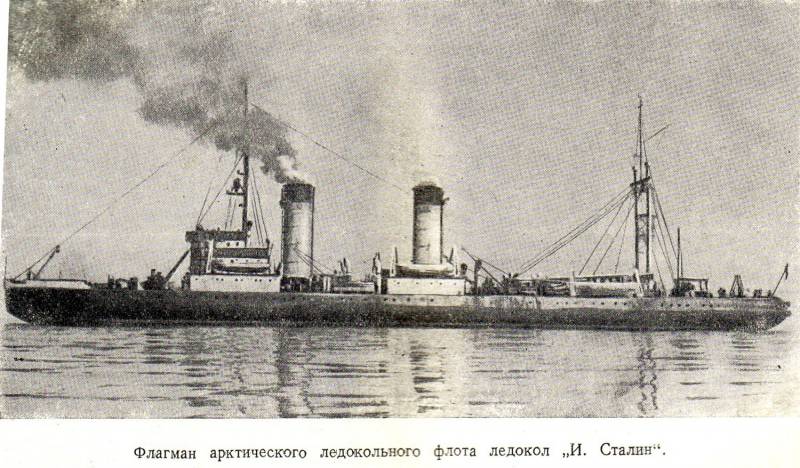
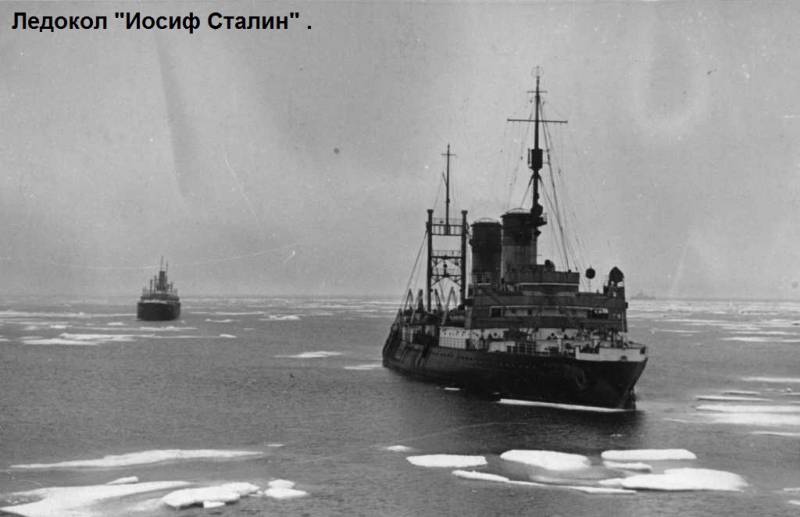
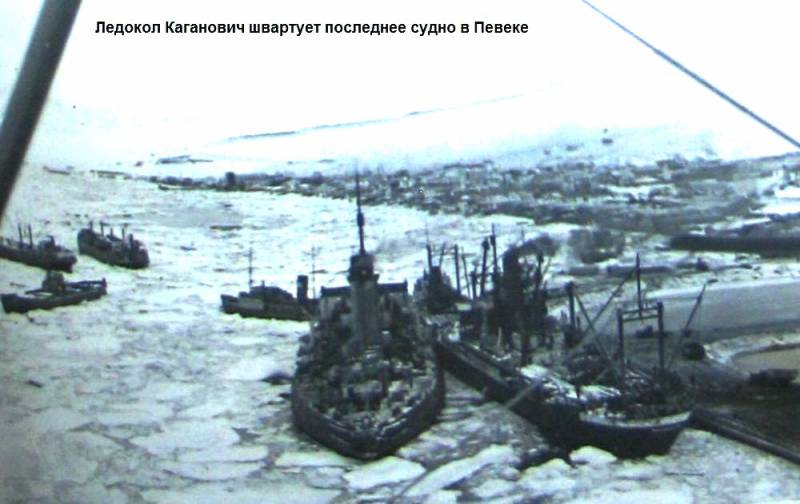
Information